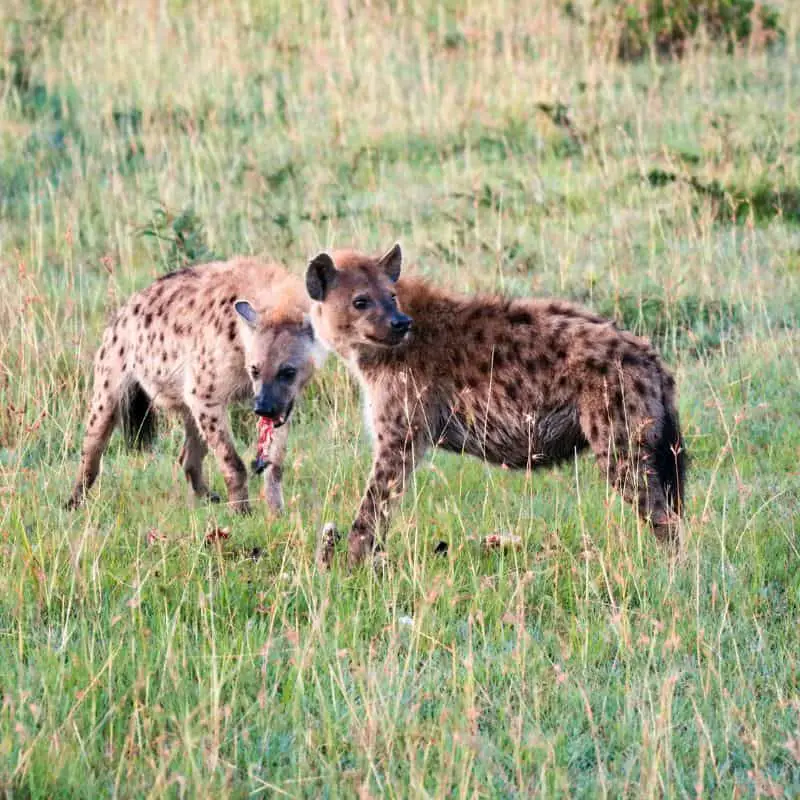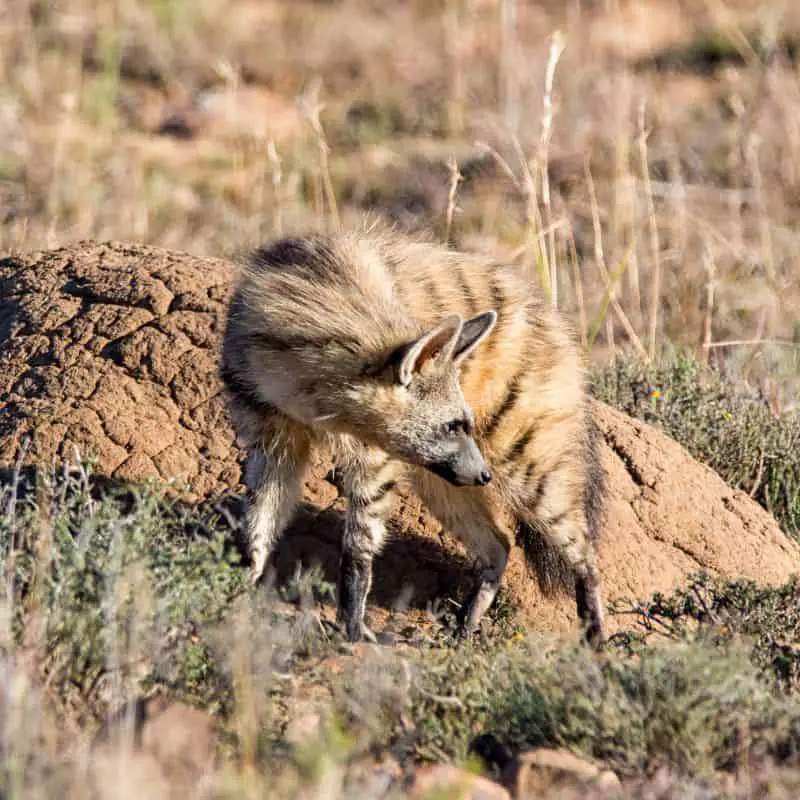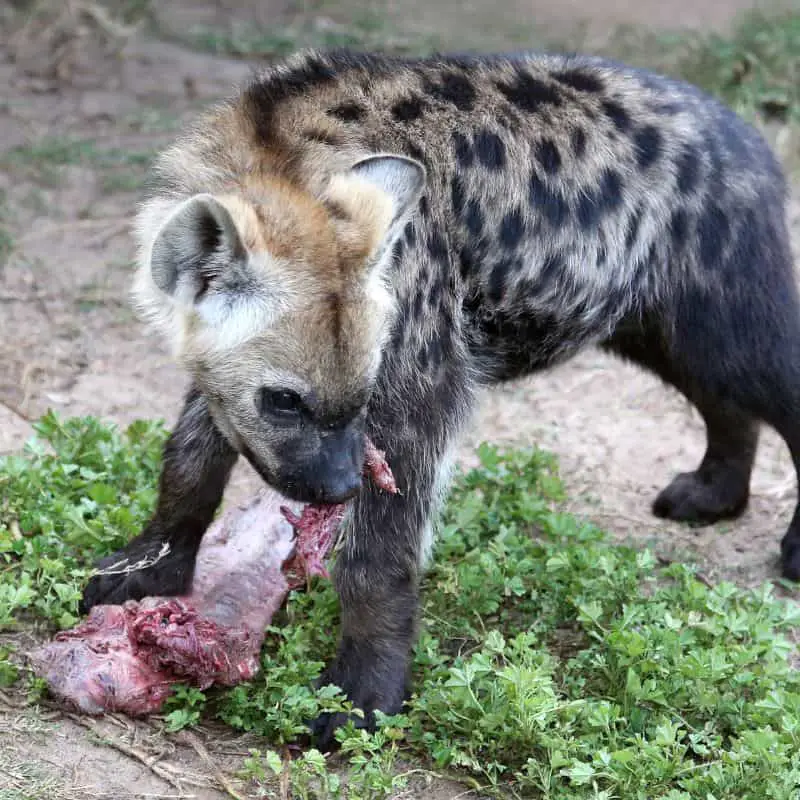Hyenas are large carnivorous mammals that inhabit various regions throughout Africa and Asia. They have an unmistakable laugh-like vocalization and strong jaws that make them well-adapted for scavenging and predation. But what do hyenas eat exactly?
Hyenas are apex predators that feed on large animals such as wildebeest, antelope, zebra, buffalo, and giraffes. They also scavenge carrion and hunt for smaller prey like insects, small reptiles, and birds. When needed, they will feed on fruits or grasses and have been known to eat eggs and insects. They consume whatever food is most readily available in their environment.
In this article, we’re going to look at the dietary habits of hyenas in greater depth; let’s get started.

What Type of Food Do Hyenas Typically Consume?
Hyenas are opportunistic feeders and scavengers, consuming various items such as small animals, insects, fruits, and vegetation. They often hunt alone but will work together to catch larger prey.
Hyenas can also scavenge the kills of other predators and have been known to consume animal dung or carcasses in times of scarcity.
They can consume large amounts of food in a single sitting and will take any opportunity they can get for sustenance.
They are incredibly adaptable, efficient predators, making the most out of their food sources and allowing them to survive in many environments.
How Does a Hyena’s Diet Vary Across Its Different Species?
Hyenas have a diverse diet that includes large animals, scavenging, carrion, and human refuse.
Each species has unique dietary habits, which can be studied to gain insight into their behavior.
Let’s dive in to explore the variations in the diet of each hyena species.

Striped Hyena (Hyaena Hyaena)
The striped hyena is an omnivorous scavenger, primarily consuming small mammals, birds, eggs, carrion, insects, and other invertebrates.
Striped hyenas will also scavenge or hunt larger prey such as wild pigs, deer, and even livestock when available.
Fruits can also be a part of the diet, such as melons and dates. Striped hyenas will also consume anthropogenic food sources, including garbage from human settlements.
They have been observed scavenging from the carcasses of other predators such as lions, leopards, and wolves.
It has even been reported that striped hyenas steal kills from tigers and bears.
Brown Hyena (Hyaena Brunnea)
The brown hyena’s diet consists primarily of small vertebrates, such as rodents and hares, insects, carrion, fruit, eggs, and plant material. They have been known to scavenge the kills of other predators.
Fungi are also a part of their diet to some extent.
Brown hyenas are also known to hunt cooperatively in groups to take down larger prey like antelopes and zebras.
The species can quickly adapt its diet to the local environment and may even scavenge garbage in urban areas. All in all, the brown hyena’s varied diet helps it survive in various habitats.
Spotted Hyena (Crocuta Crocuta)
The spotted hyena is recognized for its scavenging behavior, consuming the leftovers of other predators’ kills. But these tough animals are also capable hunters that pursue large prey such as wildebeest and antelopes.
They can even sustain themselves with smaller creatures like birds, reptiles, serpents, and bugs. Additionally, they are known to nibble on vegetation when available, including fruits and roots. They even feed on human refuse and domestic animals when it is within their territory.
With this diverse selection of food sources, the spotted hyena can survive in even challenging conditions. They actively hunt and can consume up to 32 pounds of meat in one meal.
Their diet consists primarily (95%) of prey they have caught on their own.
Their highly developed digestive systems allow them to gain nourishment from nearly anything they consume, giving them the ability to survive in their natural environment.
Aardwolf (Proteles Cristata)
The Aardwolf diet consists mainly of termites. Aardwolves are also known to feed on other insects, such as beetles, grasshoppers, and spiders.
In addition, they have been rarely observed eating small mammals and bird’s eggs or carrion from time to time. They use their sticky tongues to catch termites as they emerge from their mounds.
Aardwolves are largely insectivorous, eating up to 250,000 termites per night using their strong sense of smell.

What Do Baby Hyenas Eat?
Baby hyenas feed on their mother’s milk for the first few weeks of life.
At the age of 5, they begin to eat solid food, such as insects, small vertebrates, and carrion.
As they grow older, their diet becomes more diverse and includes larger animals killed or scavenged from other predators.

What Are the Benefits of Hyenas’ Dietary Habits?
- Hyenas possess a wide range of adaptations that enable them to survive on limited and varied resources, including scavenging from carcasses.
- They are adept at exploiting food sources typically unavailable to other predators, such as bones and hooves.
- Hyenas can consume a greater variety of foods than many other predators, including both plant and animal matter.
- Their powerful jaws and digestive systems are also well-equipped to break down bones and other hard materials, allowing them to consume sources of nutrition that would otherwise be unavailable.
- As a result, hyenas have access to more food sources than many other species, which helps them to survive during times of scarcity.
- They also have a unique social structure, which enables them to cooperate in the food search and defend their territory. This helps ensure that they always have access to adequate nutrition.
- Hyenas are also highly efficient predators. This means that they can obtain food even during periods of low availability.
- They can survive on limited resources due to their adaptation to thrive in harsh and nutrient-scarce habitats. This enables them to persist and thrive in difficult conditions.
Thus, Hyenas are important members of their ecosystems due to their versatile diets, scavenging behavior, and cooperative hunting practices.
They help disperse plant seeds, reduce insect populations, and even digest bones.
Conservation efforts must ensure that hyena populations remain stable and healthy.
How Hyenas Hunt
Hyenas are highly efficient predators that employ a diverse range of tactics to hunt their prey.
The most common method is a hunting party, consisting of several members stalking the intended victim until it is exhausted and can be easily captured.
Hyenas sometimes use pack tactics to stampede herds of antelope or gazelle in order to separate and weaken a single animal for easier capture. They also use individual hunting techniques such as lying in wait or stalking their prey using stealthy movements.
Hyenas have an impressive repertoire of vocalizations that they employ to coordinate hunts, including alarm calls, whoops, grunts, and growls.
Their powerful jaws are used for crushing the bones of their prey, and they are also adept scavengers, able to locate and eat carrion.
This way, hyenas play a vital role in the natural ecosystem as an essential top predator.
What Happens When Food Is Scarce?
When hunting or scavenging is not possible, a hyena can resort to the following methods of obtaining food:
1. Storing Food Items
Hyenas store hard-to-obtain items such as bones and stashes of food in caches that they will later return to and eat.
2. Dispersing Seeds
They disperse seeds through their feces, helping to spread the plants they eat.
3. Passive Opportunism
Hyenas will opportunistically take advantage of food sources presented by other animals, such as vultures and other scavengers that have already found a carcass or killed prey.
4. Bullying
They can use their size and strength to bully other animals away from food sources, allowing them access to much-needed sustenance.
5. Eating Insects and Other Invertebrates
Hyenas will turn to eat insects, larvae, and other small invertebrates when they cannot find larger prey items.
Overall, hyenas can be quite resourceful when obtaining food, even in times of scarcity. They can use a variety of different strategies to ensure their continued survival.
Final Thoughts On Hyenas Diets
Hyenas are incredibly versatile and adaptive animals. They have the ability to exploit food sources in a variety of ways and have been able to survive in some of the harshest environments on earth.
To ensure their continued success, we must protect hyena populations and respect their role in their ecosystems.
By understanding the complex dietary habits of hyenas and the benefits they bring to their environments, we can help ensure that these remarkable animals will continue to thrive for many generations.
